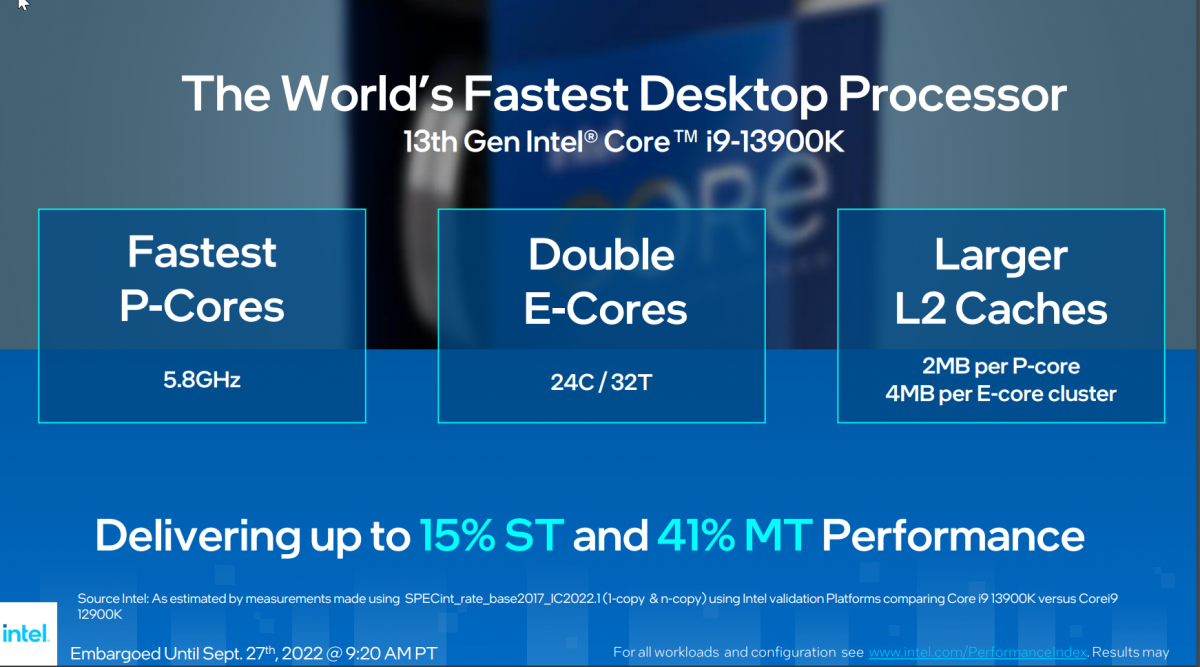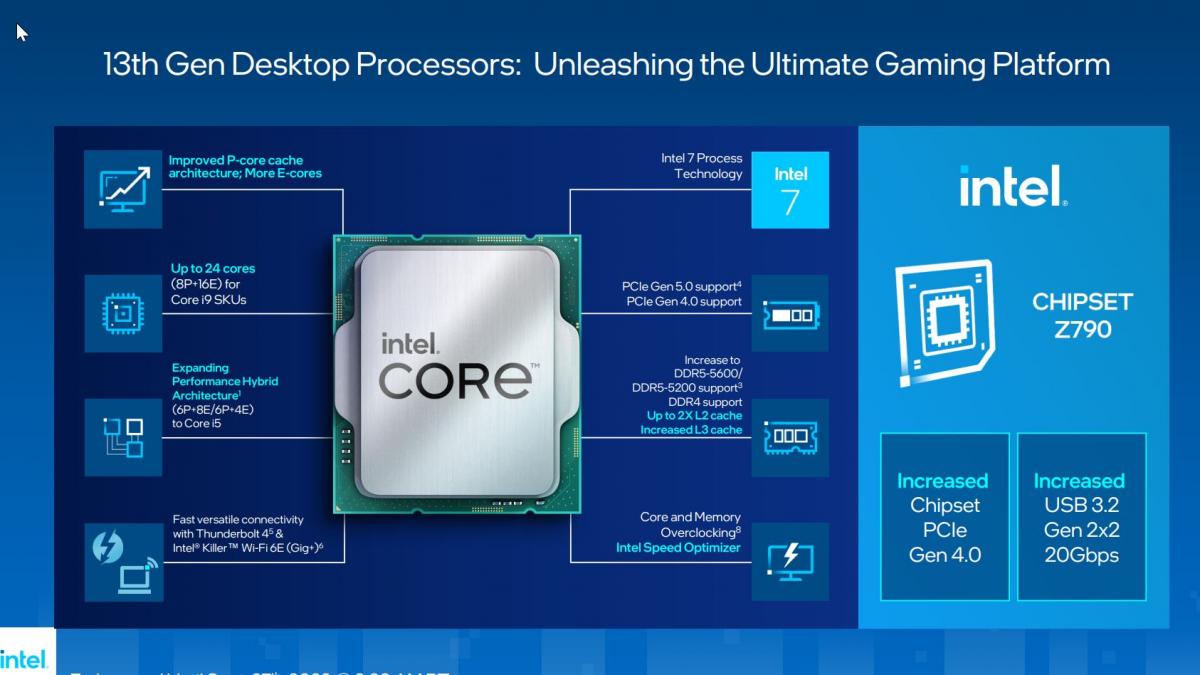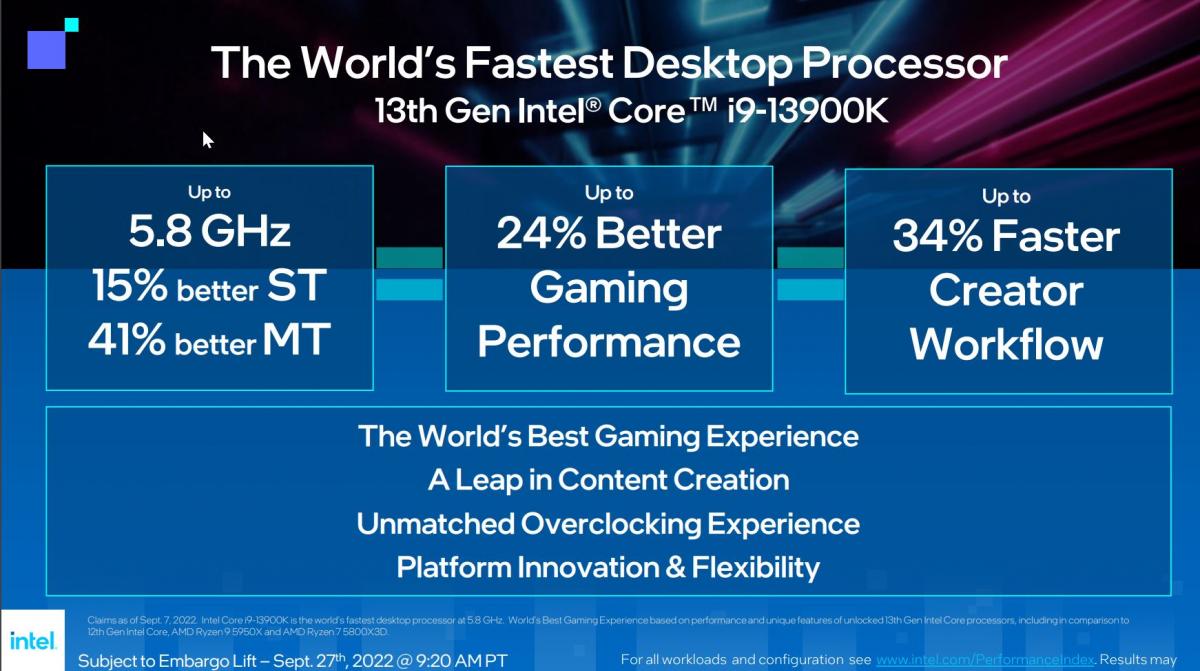Intel unveiled the 13th Gen Intel CoreTM processor family today at Intel Innovation, led by the 13th Gen Intel Core i9-13900K – the world's fastest desktop processor. The new 13th Generation Intel Core family consists of six unlocked desktop processors with up to 24 cores and 32 threads with clock rates of up to 5.8 GHz.
Intel is releasing the Core i9-13900K, Core i7-13700K, and Core i5-13600K processors. There will also be KF variations of these processors, which lack an integrated GPU but are otherwise identical to their K counterparts. The Core i9-13900K will be Intel's flagship processor. This CPU features a total of 24 cores and 32 threads, comprised of 8 P-cores and 16 E-cores. Intel claims that this CPU's Thermal Velocity boost clock can reach up to 5.8GHz. This processor's base TDP is 125W. The'maximum' tdp has been slightly increased to 253W. The Core i9-12900K supports a maximum of 241W. There are 24 cores (8P+16E) and 68 MB of combined L2 and L3 cache. This SKU's highest boost frequency is 5.8 GHz, and it will be available with integrated UHD Graphics 770 for $589 or without it for $564.
Raptor Lake processors feature 2MB L2 cache per P-core, while Alder Lake processors have 1.25MB per P-core. The CPUs now have 4MB of L2 cache per E-core cluster, up from 2MB previously. Additionally, the total amount of L3 cache is raised to a maximum of 36MB.
Intel claims a 15% improvement in single-threaded performance and a 41% improvement in multi-threaded performance. These enhancements are primarily the result of higher frequency and thread count. The new Z790 high-end platform from Intel features a more significant number of PCIe Gen4 lanes and USB 3.0 Gen 2x2 20 Gbps ports.
| Cores | Clock Frequency | Cache | Power usage | Price | |||||||
| Intel | P | E | Base P | Turbo P | Base E | Turbo E | L2 | L3 | Base | Turbo | USD |
| Core i9-13900K | 8 | 16 | 3.0GHz | 5.8GHz | 2.2GHz | 4.3GHz | 32MB | 36MB | 125W | 253W | 589 |
| Core i9-13900KF | 8 | 16 | 3.0GHz | 5.8GHz | 2.2GHz | 4.3GHz | 32MB | 36MB | 125W | 253W | 564 |
| Core i7-13700K | 8 | 8 | 3.4GHz | 5.4GHz | 2.5GHz | 4.2GHz | 24MB | 30MB | 125W | 253W | 406 |
| Core i7-13700KF | 8 | 8 | 3.4GHz | 5.4GHz | 2.5GHz | 4.2GHz | 24MB | 30MB | 125W | 253W | 384 |
| Core i5-13600K | 6 | 8 | 3.5GHz | 5.1GHz | 2.6GHz | 3.9GHz | 20MB | 24MB | 125W | 181W | 319 |
| Core i5-13600KF | 6 | 8 | 3.5GHz | 5.1GHz | 2.6GHz | 3.9GHz | 20MB | 24MB | 125W | 181W | 294 |
Z790 Chipset
In addition, Intel unveiled the Z790 motherboard chipset. Since Raptor Lake desktop is based on the same LGA1700 package as the 12th Gen "Alder Lake" desktop, the two are intercompatible; you can use 12th Gen processors with Z790 chipset motherboards out of the box, and 13th Gen processors with Z690 or other 600-series chipset motherboards with the latest BIOS. The Z790 chipset offers additional PCIe Gen 4 downstream lanes. In addition to improved downstream connectivity, you gain an extra 20 Gbps USB 3.2x2 port.
Z690 provided up to 12 downstream PCIe Gen 4 lanes, and up to 16 downstream PCIe Gen 3 lanes, the Z790 provides up to 20 downstream PCIe Gen 4 lanes and up to 8 downstream PCIe Gen 3 lanes. Both chipsets employ DMI 4.0 x8 as the chipset bus (the connection between the processor and the chipset), with bandwidth comparable to PCI-Express 4.0 x8 (128 Gbps per direction). Z790 permits motherboard manufacturers to wire up to five M.2 NVMe Gen 4 slots to the chipset or deploy a greater number of high-bandwidth onboard devices than with Z690; devices such as discrete USB4 host controllers, Thunderbolt 4 80 Gbps controllers, etc., in addition to a few PCIe Gen 4 slots.
On October 20, Intel will unveil the first six Raptor Lake processors. For instance, the Core i9-13900K is priced at $589, while the Core i7-13700K is marketed at $409. These are the same costs Intel charged for its Alder Lake equivalents. Only the Core i5-13600K has increased in price. The suggested retail price for this CPU is $319, compared to $289 for the Core i5-12600K at launch.
See all important slides at the bottom of this news ite.
-- Intel --
Led by the launch of the Intel Core ’K’ processors, the 13th Gen Intel Core desktop family will consist of 22 processors and more than 125 partner system designs – providing an uncompromising experience in both application performance and platform compatibility. Enthusiasts can take advantage of 13th Gen Intel Core processors’ performance improvements with existing Intel 600 or new Intel 700 series chipset motherboards. Combined with both the latest DDR5 memory support and continued DDR4 memory support, users can enjoy the benefits of 13th Gen Intel Core while customizing their setup based on their own feature and budget preferences.
“We are raising the standards of PC performance once again with our latest generation of flagship 13th Gen Intel Core Processors,” said Michelle Johnston Holthaus, executive vice president and general manager of the Client Computing Group at Intel. “The 13th Gen Intel Core family is the latest example of how Intel is enabling amazing experiences to happen on the PC -- at scale and across all PC product segments. Combine this with an industryleading partner ecosystem and new solutions like Intel Unison, and together we are showing the world what’s truly possible with the PC experience going forward.”
Building on a matured Intel 7 process and x86 performance hybrid architecture, 13th Gen Intel Core desktop processors enable better system performance– even through the most demanding of multitasking workloads. This includes up to 15% better single-threaded performance and up to 41% better multi-threaded performance . With this generation, Intel’s performance hybrid architecture brings together the fastest Performance-core (P-core) ever built along with up to double the number of Efficient-cores (E-core) – delivering improved single-threaded and multi-threaded performance that enables:
- World’s best gaming experience: Available with up to 24 cores (8 P-cores, 16 Ecores) and 32 threads, the new Core i9-13900K provides the best experience for gaming, streaming and recording. With up to 5.8 GHz and 15% better single-thread performance, it can push high frame rates and allows for unleashed gaming experiences across top titles.
- Continued advances in content creation performance: The 13th Gen Intel Core desktop processor lineup adds more E-cores and up to 41% better multi-threaded performance to handle multiple, compute intensive workloads to keep people in the creative flow.
- An Unmatched Overclocking Experience 5 : The 13th Gen Intel Core processor offers an unmatched overclocking experience for everyone – from experts to beginners. 13th Gen Intel Core processor users can see higher average overclocking speeds across P-cores, E-cores and DDR5 memory. Intel also updated its easy 1-click overclocking feature, Intel® Speed Optimizer, to support 13th Gen processors so users can overclock with minimal effort. And the robust Intel® Extreme Memory Profile (XMP) 3.0 ecosystem provides a wide selection of overclocking modules. When coupled with Intel® Dynamic Memory Boost, this feature provides a hassle-free memory overclocking experience with both DDR4 and DDR5.
Industry-Leading Features for Desktop Platforms
The 13th Gen Intel Core desktop processors empower users with leading-edge performance and experiences across gaming, content creation and work, with several new and improved features including:
- Intel® Adaptive Boost Technology and Thermal Velocity Boost – opportunistically boosting processor clock frequencies based on power and thermal headroom during a given workload. Available in Intel Core i9 unlocked SKUs.
- More E-cores across Intel Core i5, i7, i9 – powering a big leap in multi-threaded performance and better multi-tasking/mega-tasking experience for users.
- PCIe Gen 5.0 support, with up to sixteen lanes off the processor.
- Increased memory support to DDR5-5600 and DDR5-5200, while maintaining DDR4 compatibility.
- Up to 2x the L2 cache and increased L3 cache.
Introducing the Intel 700 Series Chipset with Backward Compatibility
Alongside the 13th Gen Intel Core desktop processors, Intel is launching the new Intel 700 Series chipset with advanced features for increased reliability and performance. Eight additional PCIe Gen 4.0 lanes combined with PCIe Gen 3.0 provide 28 total lanes off the chipset, increased USB 3.2 Gen 2x2 (20 Gbps) ports provide improved USB connectivity speed, and DMI Gen 4.0 increases the chipset-to-CPU throughput for fast access to peripheral devices and networking. Additionally, Intel is bringing forward and backward compatibility. Take advantage of 13th Gen Intel Core processor performance improvements with existing Intel 600 chipset-based motherboards.
13th Gen Intel Core desktop ‘K’ processors and the Intel Z790 chipset will be available starting October 20, 2022, including boxed processors, motherboards and desktop system sales.













